![]()
![]()
![]()
Use LEFT and RIGHT arrow keys to navigate between flashcards;
Use UP and DOWN arrow keys to flip the card;
H to show hint;
A reads text to speech;
46 Cards in this Set
- Front
- Back
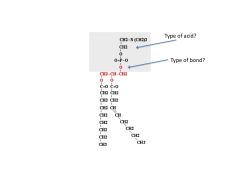
Also, what is the backbone?
|

1. Phosphatidic acid
2. Ester 3. On a glycerol backbone |
|
|
Where does synthesis of phosphatidic acid take place?
|
It occurs in the endoplasmic reticulum and outer mitochondrial membrane.
|
|
|
What is phosphatidic acid and what are its basic components?
|
1. Glycerol Backbone
2. Saturated fatty acid on C1 3. Unsaturated FA on C2 4. Phosphate group on C3 |
|
|
Where does synthesis of phosphatidic acid take place?
|
It occurs in the endoplasmic reticulum and outer mitochondrial membrane.
|
|
|
What is phosphatidic acid and what are its basic components?
|
1. Glycerol Backbone
2. Saturated fatty acid on C1 3. Unsaturated FA on C2 4. Phosphate group on C3 |
|
|
Draw the simplest phosphatidic acid.
|
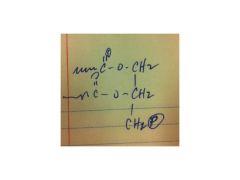
NOTE: There's not an extra H on C2 as pictured.
|
|
|
Synthesis of PHOSPHATIDATES can be achieved in two ways - both require a charged intermediated. What are these two intermediates and what creates them? (p220)
|
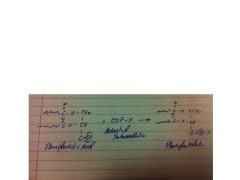
(Note: I had a problem making this card - the image represents the first method only)
1. A charged Phosphatidic acid made with CTP. 2. A charged alcohol also made from CTP |
|
|
Second to nucleic acid synthesis what is the most important role of CTP? (Make sure you know the two rxns using CTP on p220)
|
Phospholipid biosynthesis.
|
|
|
Ether phospholipids are characterized by an ether linkage at the:
What are the three ingredients of Ether Phospholipids? (p222) How are they typically used in the cell? |
1. C1 Carbon
2. Dihydroxyacetone, long-chain fatty acids, and long-chain fatty alcohols. 3. Second messenger signaling - e.g. PAF |
|
|
Review the Ether Phospholipid pathway on p222
|
Review the Ether Phospholipid pathway on p222
|
|
|
What type of phospholipid is Platelet Activating Factor? What does PAF induce? (p222) How is the structure unusual compared to other phospholipids? What does this enable it to do?
|
Ether phospholipid. Induces immune responses. It includes an acetyl group at C2 instead of a FA. This increases its solubility and allows it to function in an aqueous environment.
|
|
|
What are Plasmalogens? What enzyme is key to their synthesis? Where is this enzyme located? (p223)
|
Ether phospholipids that contain an unsaturated ether at C1. Desaturase catalyzing enzyme oxidizes the saturated FA at C1 to an unsaturated FA at C1. The oxidase enzyme is located in the ER.
|
|
|
What are Phospholipases? What are they're two major activities?
|
The specifically cleave phospholipids. They are involved in 1) phospholipid remodeling and 2) intracellular signaling.
|
|
|
Phospholipase A1 and Phospholipase A2 remove FAs from which Carbons on the glycerol backbone? What does this permit? What role does Phospholipase C and Phospholipase D have?
|
C1 and C2 respectively. Permits re-esterification rxns with other FA CoAs (i.e. remodeling).
Phospholipase C cleaves C3 phosphodiester to Diacylglycerol and Phospholipase D cleaves C3 to produce Phosphatidic acid (signaling). |
|
|
Draw a diagram showing where each of the four phospholipases cleave. Name the products of C and D.
|
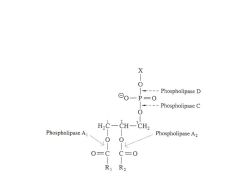
C makes diacylglycerol
D makes phosphatidic acid. |
|
|
Based on your knowledge of phospholipases, what would cleavage of PIP2 (phosphatidylinositol 4,5-bisphosphate) by phospholipase C produce? (p224)
|
Diacylglycerol (DAG) and Inositol 1,4,5-triphosphate (IP3).
|
|
|
Describe how cleavage of PIP2 by phospholipase C (PLC) causes cellular response. (P225).
|
Hormone binds and activates PLC. PLC cleaves PIP2 to DAG and IP3. DAG remains bound to membrane and IP3 migrates to ER where it stimulates Ca2+ release. Ca2+ and DAG activate PKC and initiate cellular responses.
|
|
|
How are proteins typically anchored to the PM? How are they typically arranged? How can they have a signaling function? (p225)
|
Glycosyl Phosphatidylinositol (GPI) is an anchor that allows some extracellular proteins to be anchored to the plasma membrane. They are typically arranged in clusters that can easily be released for signaling purposes by Phospholipase C.
|
|
|
What are eicosanoids? What are they synthesized from? Since eicosanoids are FAs, what do they have to do with membrane Phospholipids? (p226)
|
They are short-lived paracrine hormones that act locally on various tissues/systems (think pain, think aspirin, think COX inhibitor). Synthesized from arachidonic acid. Since arachidonic acid is typically bound to C2 in membrane-bound phosphopholipids, it is readily available for synthesis.
|
|
|
What are the functions of:
1. Prostacyclin (PGI2) 2. Prostaglandin (E2) 3. Thromboxane A2 (p227) |
1. Vasorelaxation and platelet declumping
2. Fever, pain, uterine contraction, 3. Vasoconstriction and platelet activation |
|
|
Of prostacyclin, prostaglandin, and thromboxane, which are 5-member rings and which are 6 member?
(p277 - might want to review this page - lots of stuff) |
Prostaglandins and prostacyclin are 5-member rings. Thromboxane is a 6-member ring.
|
|
|
For the prostaglandins, where are their functional groups located?
|
On the cyclopentane ring.
|
|
|
What is a defining feature of all leukotrienes? How many O2 are added to arachidonic acid to make leukotriene?
|
Four double bonds. 1 Oxygen molecule
|
|
|
What is the difference between cycloxygenase and lipoxygenase?
|
Cycloxygenase catalyzes addition of two oxygen molecules. Lipoxygenase catalyzes addition of one oxygen to arachidonic acid.
|
|
|
What are lipoxins characterized by?
What are leukotrienes characterized by? |
Lipoxins = hydroxyl groups at C5 and C6
Leukotrienes = 4 double bonds. |
|
|
Leukotrienes and Lipoxins have a yin/yang relationship. Describe that.
|
Leukotrienes are pro-inflammatory substances and Lipoxins are anti-inflammatory.
|
|
|
Review p230 for how Leukotrienes and HETE's are targeted pharmacologically:
1. 5-LO's FLAP protein is targeted 2. |
Review p230 for how Leukotrienes and HETE's are targeted pharmacologically.
|
|
|
Draw/compare a phospholipid to a sphingolipid.
*the drawing is wrong - should have an amine at C2 |
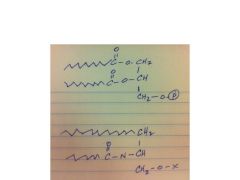
|
|
|
For sphingolipids, what is the backbone (i.e. the equivalent to glycerol in phospholipids)? Where/how do they differ?
|
Ceremide. They differ by their polar head group on C3.
|
|
|
For Sphingomyelins, Glycosphingolipids, and Gangliosides, describe 1) the polar group at C3 and 2) where they are most abundant. (p 231)
|
Sphingomyelins: 1) Phosphocholine and Phosphoethanolamine. 2) Mostly found on Myelin
Glycosphingolipids: 1) Cerebrosides (one sugar group) or Globosides (more than one sugar group) 2) Found at outer surface of the plasma membrane Gangliosides 1) Oligosaccharides with one or more N-acetylneuraminic acid 2) Found in gray matter. |
|
|
What two compounds are used to synthesize sphingosine? What is the source of C1, C2,the amino group, and the remaining C atoms?
|
Palmitoyl CoA and Serine. Serine provides C1, C2 and the amino group while Palmitic acid provides the remaining carbons.
|
|
|
In Sphingosine synthesis, what role does NADPH and FAD play? (p232)
|
NADPH reduces the carbonyl to a hydroxyl group and FAD introduces a double bond.
|
|
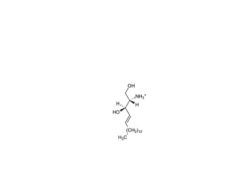
What molecule is this? Based on what?
|

Sphingosine. Based on the Hydroxyl, Amino, Hydroxyl group on carbons 1, 2, and 3.
|
|
|
Once sphingosine is made, what is the next step? (p232)
|
Addition of a long-chain fatty acyl-CoA to produce Ceramide.
|
|
|
Once ceramide is made, what can be added and where are these groups added? (p232)
|
To the terminal hydroxyl group on Ceramide, Phosphatidyl Choline can be added or UDP-Glucose
|
|
|
If Phosphatidyl Choline is added to ceramide, what does it make? What if UDP-Glucose is added?
|
Sphingomyelin and Cerebroside respectively.
|
|
|
Describe the general synthesis of gangliosides. What enzyme adds these sugars?
|
It begins with cerebrosides and proceeds through globosides until a sialic acid residue is attached. Glycosyltransferases adds sugars to the structure.
|
|
|
What terminates the addition of sugars in ganglioside synthesis?
|
Sialic residue.
|
|
|
When sphinglolipids are degraded in lysoymes, what is produced? What is the condition called when sphingolipids cannot be broken down in the body?
|
Sphingosine and fatty acids. Sphingolipidoses.
|
|
|
What causes Tay-Sach's disease?
|
It's a disorder of ganglioside degradation caused by a deficiency in Beta-hexosaminidase. Neurons become swollen with lipid filled lysozymes (i.e. everything upstream of defect is accumulating).
|
|
|
What is Niemann-Pick diease?
|
A deficiency in sphingomyelinase that degrades sphingomyelin into ceramide and phosphocholine. As a consequence, everything upstream accumulates and causes problems.
|
|
|
What are polyisoprenoids composed of? What are some examples of important ones?
|
Derived from 5-carbon isoprene units rather than fatty acids. Important ones include cholesterol, steroid hormones, bile acids.
|
|
|
Steroids are characterized by a ?-ring structure that is synthesized from what?
|
4-ring; squalene
|
|

Name these compounds that are important moieties added to phosphatidates.
|
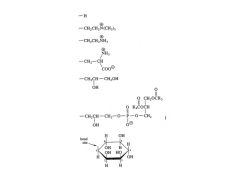
1. Water
2. Choline 3. Ethanolamine 4. Serine 5. Glycerol 6. Phosphatidyl-glycerol 7. myo-Inositol |
|
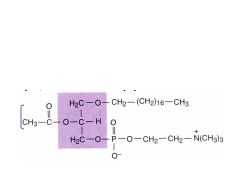
What molecule is this? What are two unique things about it at C1 and C2?
|

Platelet Activating Factor.
1. Has an ether group at C1 2. Has acetyl moiety at C2 rather than long chain FA. This makes it very water soluble. **note - it mediates anaphylactic shock |
|
|
Why might it be useful to take a baby aspirin every day? p227
|
Bc aspirin inhibits thromboxane synthesis longer than prostacyclin synthesis. Since prostacyclin is involved in vasorelaxation and platelet declumping, then less likely to have a blood clot. But then, more likely to bleed out.
|

